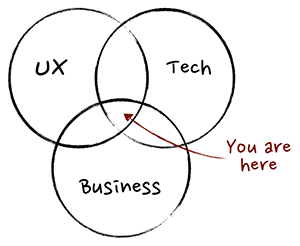If you're already involved in software development as a designer, programmer, tester or another specialist and are looking to upgrade your role and affect the project's lifecycle as well as company's product strategy, you should consider to become a Software Product Manager (SPM).
What is a Software Product Manager?
Software Product Manager is a person who:
- acts as a product's CEO and advocate
- is in charge of corporate product development strategy
- has deep understanding of relevant market segments, users and portfolio
- tests business cases every now and then
- is responsible for risks management
- is enthusiastic about your company's software product
- understands user behavior patterns and building blocks of effective communication

Salaries
That's how Software Product Manager salaries vary per country (work experience: 4+ years, all salaries are gross and per annum):
Ukraine: $30,000 - $42,000
United States (Chicago): $85,241 - $162,300
Germany: $60,000 - $115,000
UK: $77,240 - $100,000
As we can see, salaries for SPM in the Western world are generous, with average pay above 6 figures per year. Considering potential for bonuses and profit sharing, the total cash payments to SPMs can peak near $162K depending on individual performance.
However, the same expertise can be found at a much lower cost offshore in countries like Ukraine.
Skills and responsibilities
SPM's key goal is to continuously improve product in each phase of its lifecycle. SPMs communicate both with a software development team (developers and engineers, visual designers, UX/UI designers, QA) and the end user. At a certain stage communication with users may account for over 70% of SPM's daily job.
Some of the responsibilities of Software Product Managers include, but aren't limited to:
- Daily interaction with customer and their project team
- Gathering requirements to spec out the project, expectations management
- Feature specification design (goals, analytics, wireframes)
- Interaction with designers (feedback on completed tasks)
- Design, upgrade and monitoring of product dashboards
- A/B testing
- Coordination of interaction with agencies that monitor user behaviors (e.g., UserTesting, Validately, Ask your Target Market, etc.), analysis of information received
- Product decision making based on quantitive data
Communication with customer is the number one challenge for SPMs. Finding a balance between opportunity and reality is critical, because what user wants is oftentimes a far cry from what customer wants to have developed. And your task is to deliver target user feedback to the customer and get their buy-in for this. It usually involves change resistance that SPMs should be able to deal with. So, if you know how to convince people and turn them into your allies using correct arguments, this job is right for you!
A typical workday of a SPM is hard to describe; tasks depend on a current project phase. To repetitive tasks belong:
- Demo of the latest mockup / prototype, details discussion and getting approval
- Leading a team standup meeting, tasks distribution among team members
- Work with users: testing new features, A/B split, collecting focus group feedback, keeping backlogs
- Work with designers: finalizing mockups, collecting feedback, getting customer's approval
- Market research: analytics, news, competitive research
It's a must for a good SPM to spend at lest 1 hour at work on self-education: reading books, attending events, talking to mentors, taking an online course, etc
Tasks and responsibilities may vary depending on project type and specificity. In many cases, there's no assigned SPM on project, so this role is shared among CEO, CTO, PM and head designer.
Many are curious about the difference between a Product Manager and a Project Manager (PM). Unlike the latter, SPM makes business decisions, gets involved in marketing and product shaping. As such, a Product Manager is able to affect the product and its development, while a PM does't deal with a product directly, but manages this or that product related project and is responsible for helping customer or employer attain their business goals.
Sometimes these roles are mixed and one person may fulfill both functions. Again, it all depends on the project type. For instance, in case of Intersog, some of our projects have SPMs, and some have PMs only. Besides interacting directly with customer and their PMs, our product managers involved in eHealth projects also have to communicate with real physicians to get their feedback on features deployed, and coordinate compliance with HIPAA and other Health IT standards.
How to become a Software Product Manager?
You should have the following basic skills to develop into a SPM:
- Technical knowledge and understanding of web / software development
- Strong domain knowledge and expertise
- Strong social skills, stress resistance, negotiating skills
Intersog SPMs recommend the following resources for self-education:
1. The Lean Product Playbook by Dan Olsen
2. Intercom on Product Management by Des Traynor & John Collins
3. Software Product Management course on Coursera
If you have no technical background, you should consider learning web and mobile development lifecycle and processes. Check out Coursera for a variety of courses.
Speaking about tools used by SPMs, let's point out the following:
- UX Design: Balsamiq Mockups, Proto.io, Axure, Uxpin, Bootstrap;
- Agile Development: Trello, Pivotal Tracker, JIRA Agile;
- Target audience research: UserTesting, Validately, Ask your Target Market;
- Analytics and A/B Testing: Google Analytics, KISSmetrics, Mixpanel, Flurry.
Just like any other profession, SPM requires a lot of field work, experience working on real-life client projects and active trend-watching to stay in the know about what's happening in the market now.
Career opportunities in Software Product Management
When it comes to career growth opportunities, you actually have 3 main options:
- Develop horizontally, i.e. gain experience and knowledge with each new project
- Create own product / launch startup
- Become an advisor, i.e. help evolve a software product as an independent or 3rd party consultant for equity share or at an hourly rate (the most viable option in Western countries today).

